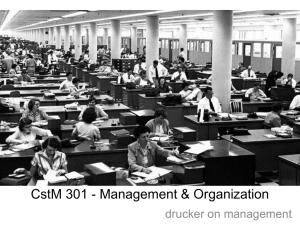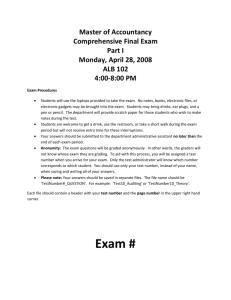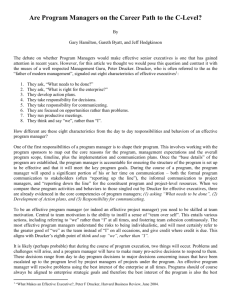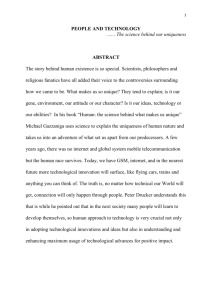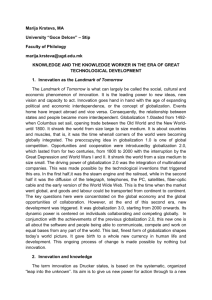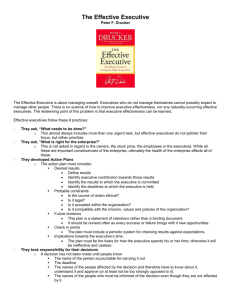An Anchor for Management Students: The Value of Drucker's
advertisement
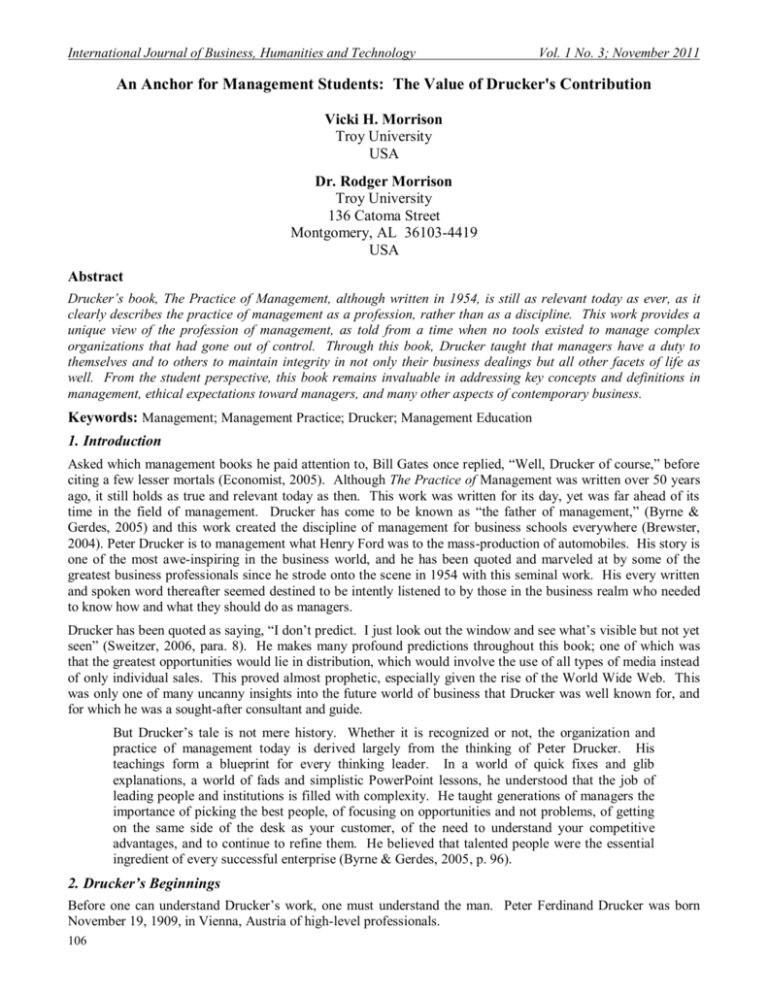
International Journal of Business, Humanities and Technology Vol. 1 No. 3; November 2011 An Anchor for Management Students: The Value of Drucker's Contribution Vicki H. Morrison Troy University USA Dr. Rodger Morrison Troy University 136 Catoma Street Montgomery, AL 36103-4419 USA Abstract Drucker’s book, The Practice of Management, although written in 1954, is still as relevant today as ever, as it clearly describes the practice of management as a profession, rather than as a discipline. This work provides a unique view of the profession of management, as told from a time when no tools existed to manage complex organizations that had gone out of control. Through this book, Drucker taught that managers have a duty to themselves and to others to maintain integrity in not only their business dealings but all other facets of life as well. From the student perspective, this book remains invaluable in addressing key concepts and definitions in management, ethical expectations toward managers, and many other aspects of contemporary business. Keywords: Management; Management Practice; Drucker; Management Education 1. Introduction Asked which management books he paid attention to, Bill Gates once replied, “Well, Drucker of course,” before citing a few lesser mortals (Economist, 2005). Although The Practice of Management was written over 50 years ago, it still holds as true and relevant today as then. This work was written for its day, yet was far ahead of its time in the field of management. Drucker has come to be known as “the father of management,” (Byrne & Gerdes, 2005) and this work created the discipline of management for business schools everywhere (Brewster, 2004). Peter Drucker is to management what Henry Ford was to the mass-production of automobiles. His story is one of the most awe-inspiring in the business world, and he has been quoted and marveled at by some of the greatest business professionals since he strode onto the scene in 1954 with this seminal work. His every written and spoken word thereafter seemed destined to be intently listened to by those in the business realm who needed to know how and what they should do as managers. Drucker has been quoted as saying, “I don‟t predict. I just look out the window and see what‟s visible but not yet seen” (Sweitzer, 2006, para. 8). He makes many profound predictions throughout this book; one of which was that the greatest opportunities would lie in distribution, which would involve the use of all types of media instead of only individual sales. This proved almost prophetic, especially given the rise of the World Wide Web. This was only one of many uncanny insights into the future world of business that Drucker was well known for, and for which he was a sought-after consultant and guide. But Drucker‟s tale is not mere history. Whether it is recognized or not, the organization and practice of management today is derived largely from the thinking of Peter Drucker. His teachings form a blueprint for every thinking leader. In a world of quick fixes and glib explanations, a world of fads and simplistic PowerPoint lessons, he understood that the job of leading people and institutions is filled with complexity. He taught generations of managers the importance of picking the best people, of focusing on opportunities and not problems, of getting on the same side of the desk as your customer, of the need to understand your competitive advantages, and to continue to refine them. He believed that talented people were the essential ingredient of every successful enterprise (Byrne & Gerdes, 2005, p. 96). 2. Drucker’s Beginnings Before one can understand Drucker‟s work, one must understand the man. Peter Ferdinand Drucker was born November 19, 1909, in Vienna, Austria of high-level professionals. 106 © Centre for Promoting Ideas, USA www.ijbhtnet.com His mother, Caroline, studied medicine, and his father, Adolph, was a lawyer. Their home was haven to a constant stream of intellectuals. He graduated school and moved to Hamburg, working as an apprentice at a cotton trading company, then as a journalist, writing for The Austrian Economist. From there he went on to write for the Frankfurter General-Anzeiger, while obtaining his doctorate in international law and public law from the University of Frankfurt in 1931. The Austrian economist, Joseph Schumpeter, a friend of his fathers‟, was one of the early influences in his life. He heard John Maynard Keynes lecture at Cambridge in 1934 causing him to realize that most economic students were interested in the behavior of commodities, while he was interested in people‟s behaviors instead (Beatty & Drucker, 1998). As a young writer, Drucker compiled an article called, The Jewish Question in Germany, (Drucker, 1936) which was burned and banned by the Nazis (Byrne & Gerdes, 2005). He left in 1933 for England and married Doris Schmitz in 1934, who he had known at their days at the University of Frankfurt. They moved to the United States and became naturalized citizens in 1943. Drucker taught at Bennington College in Vermont from 1942-1949, and at the New York University from 1950 to 1971, and afterward taught at Claremont Graduate University. The management school became the “Peter F. Drucker Graduate School of Management” in his honor in 1987. He taught there last at the age of 92 in 2002. He died peacefully in his sleep at his home in Claremont, California, on November 11, 2005, just eight days short of his 96th birthday. Drucker‟s first book, Concept of the Corporation (Drucker, 1983), was a result of a two-year long study beginning in 1943 of the inner workings of General Motors, one of the largest companies in the world at that time. In the book, Drucker suggested that GM might want to revisit many of their policies on customer, dealer, and employee relations. GM‟s chairman, Alfred Sloan, was upset with the book and would never mention it, treating it as if it did not exist (Drucker, 1979). Drucker had a long and varied consulting and writing career. He predicted many of the major developments of the late twentieth century, i.e., decentralization, privatization, Japanese rise in economic power, marketing importance, and the need for continued learning due to the information age. He also coined the term, “knowledge worker” in 1969 (Economist, 2005, p. 71), and considered knowledge work productivity the new frontier for business (Drucker, 1983, p. xviii). He leaves a legacy behind him that will endure for generations of prospective business and management students to come. Key among the many things that leaves the student is a firm understanding of what it means to be a manager. 3. Nature of Management “The manager is the dynamic, life-giving element in every business” (Drucker, 1954, p. 3). Thus, Peter Drucker begins to explain his theory of what has come to be known as the discipline of management. He believed that as long as Western civilization prevailed, the philosophy of management would remain predominant throughout, and that any business enterprise must have management to be alive and functioning. He answers the all-encompassing question: What does management do? The reason for the existence of a business is to supply economic goods and/or services. Management is the specific organ of business enterprise, and the vital essence of that enterprise is economic performance. The measure of management‟s success or failure is this performance. The first job of management is managing a business. To do this successfully, a manager can improve his performance through the systematic study of principles, acquiring knowledge, and analysis of his own performance throughout all levels of his job as manager. Drucker identifies three distinct aspects of management: managing a business, managing managers, and managing workers and work. All management decisions affect all three of these aspects, and must address all three effectively. Drucker believed that management is a practice rather than a science or a profession, albeit containing rudiments of both. Managing goes beyond reaction and adaptation. It involves responsibility for planning, carrying through changes in the economic environment of the business, for pushing back limitations on the businesses‟ freedom to act on its behalf, and must be managed by objectives. Management must make a productive enterprise out of the combination of human and material resources. The business must transform its resources into a good or service demanded by society. This requires management of human resources by managers. Managers are among the costliest resources of organizations and utilization of this investment as fully as possible is a major requirement of every enterprise. Managing workers and work implies organization of the work to make it suitable for human beings to do. There is the additional management problem of consideration of both short-term and long-term planning. 107 International Journal of Business, Humanities and Technology Vol. 1 No. 3; November 2011 Automation was one of the challenges that faced management at the time of the writing of this book in 1954. There were many lurid tales told of a push-button society and fear abounded concerning the stability of jobs. Drucker soothed these fears with his statements-in-fact focusing on automation as a concept that aims at arriving at the best process. He believed that technology, though causing some displacement, would employ more people, creating the need for more highly skilled and trained workers. He related this new phenomenon to the industrial revolution of the early twentieth century, which created more highly skilled, educated, and wealthier people with a higher standard of living. This new era of automation would create the need for more managers because of decentralization, flexibility, and independence. 4. Managing a Business Drucker used the example of the Sears, Roebuck Co., which catered to the farmers and their needs, to detail management of a business. Innovation of five areas was the key to this company‟s success story. They were: systematic merchandising; the finding and developing of sources of supply for the farmer‟s specific needs; a mailorder catalog to circumvent shopping trips to the city; a money-back guarantee; the mail-order plant to fill orders quickly and cheaply. A human organization for this new kind of business had to be built from the ground up. Richard Sears gave the company its name but Julius Rosenwald became known as the father of the distribution revolution (Drucker, 1954, p. 29). Otto Doering designed the Chicago mail-order plant for Sears in 1903, five years before Henry Ford‟s first Model A rolled off the conveyor belt. 1 The first prediction, among many, that Drucker made in his book was that of, “Servicing the Sears products in the home might well become of central importance—perhaps eventually as important as was the original money-back warranty of forty years ago” (Drucker, 1954, p. 33). Amazing how correct his thinking has turned out! A business enterprise is created and managed by people, and it cannot be defined or explained in terms of profit. Profit is only the test of the validity of a business, not its cause, or it is the rationale of its behavior and business decisions. “The problem of any business is not the maximization of profit but the achievement of sufficient profit to cover the risks of economic activity and thus to avoid loss (Drucker, 1954, p. 36). Drucker believed the customer to be the foundation of the business and the reason for its existence. I thought it interesting that he said, “And it is to supply the consumer that society entrusts wealth-producing resources to the business enterprise” (Drucker, 1954, p. 37). Marketing and innovation are the two entrepreneurial functions that set the business apart from all other human endeavors. Marketing is delivering what the market needs and innovation is the provision of better and more economical goods and services. One of the other points Drucker makes that is particularly observant was that, “A business is set apart from all other human organizations in that it markets a product or service. Neither Church, nor Army, nor School, nor State does that. Any organization in which marketing is either absent or incidental is not a business and should never be run as if it were one” (Drucker, 1954, pp. 37-38). Many businesses have failed solely because they did not pay attention to this one detail of their business design. The productive utilization of our wealth-producing resources is never achieved by mere brawn, replaced by either mechanical equipment or the substitution of planning for working. “The basic factor in an economy‟s development must be the rate of “brain formation,” the rate at which a country produces people with imagination and vision, education, theoretical, and analytical skill” (Drucker, 1954, p. 42). Managing a business requires managers to be entrepreneurial and creative rather than adaptive, and to set objectives to attain the best possible result for the maximization of its profits. This requirement requires management to decide what kind of business it is and should be. Satisfying a want of the consumer is the ultimate goal of a business. A business must therefore ask itself, “Who is the customer?” and, “What does the customer buy?” Of immense importance is also knowing what is valuable to the customer. Managing a business requires setting precise objectives and balancing a variety of needs and goals, which requires judgment. “Objectives are needed in every area where performance and results directly and vitally affect the survival and prosperity of the business” (Drucker, 1954, p. 63). Objectives are set in eight areas: market standing; innovation; productivity; physical and financial resources; profitability; manager performance and development; worker performance and attitude; and public responsibility. 1 Drucker‟s note: There is indeed a persistent legend at Sears that Henry Ford, before he built his own first plant, visited and carefully studied the then brand-new Sears mail-order plant. 108 © Centre for Promoting Ideas, USA www.ijbhtnet.com One way to set these objectives is to determine what to measure in each area and what they should be measured against. This was an ongoing process of research and development at the time of the writing of this book. The key thing to remember about business objectives is that they serve to determine what action to take now to obtain results in the future. Predictions for the next several years can only be guesses, but those educated and based upon a rational appraisal of the evidence and possibilities are always preferable to those that are hunches and gambles. Management decisions must allow for change, adaptation, and reclamation. Management must strive to go beyond physical production limitations, and try to turn these limitations into opportunities for improvement instead. This can often be accomplished by using simple logic. The three systems of production are uniqueproduct production; mass production, old and new; and process production, with process production being the most advanced. “Management must demand that those responsible for production know what system of production is appropriate, and apply the principles of that system consistently and to the limit” (Drucker, 1954, p. 103). 5. Managing Managers There are basic problems in the business enterprise in managing managers, including order, structure, motivation, and leadership. Managers are still among the costliest and most demanding investments of a business. How well they are managed will often determine whether a business meets its goals or not. A worker‟s attitude also reflects management‟s competence and attitude, which has an effect on performance. Managers therefore share in the responsibility for the performance of the business itself. Henry Ford had all but ruined his company through his disallowance of managers, and when Henry Ford II took over in the early 40s, he took his managing concepts from his competitor, General Motors. Henry Ford‟s concept of the executive as a personal delegate of the CEO by this time had been replaced by the manager whose authority was the responsibility of the job he was given to do. Management is necessary because one man cannot run a business entirely on his own. Managers must manage by objectives and self-control, which therefore necessitates a proper structure to the manager‟s job. There must also be a right spirit of cooperation in the organization. If the business is large enough, it requires a chief executive and a board of directors and it is vital that it provide for managerial continuity. Finally, it must have sound structural principles of management built into the organization of the company. Development of tomorrow‟s leaders must consist of offering challenges and opportunities for individual growth and development. This cannot consist of just promotion planning, but rather development of the entire management structure as a whole. However, this does include a focus on self-motivated and quality individuals. 6. Structure of Management The structure of an organization must make possible objectives of the business for many years into the future. The three specific ways to determine the structure needed are activities analysis; decision analysis; and relations analysis. An analysis of the typical functions that make up a business will determine what work has to be done, the kinds of work that belong together, and the importance of each activity on the organization‟s structure. In regards to decision analysis, Drucker states that, “It is no accident that the greatest single cause for the failure of businesses to consolidate their growth, and for their relapse into smallness if not into bankruptcy, is the failure of the boss to give up making decisions when they are no longer his to make” (Drucker, 1954, p. 197). He continues to reiterate that a decision should always be made at the lowest possible level, yet at a level that will insure all activities and objectives that are affected were taken into consideration. In the area of relations analysis, the first thing to consider is the upward relationships of the manager, which is straightforward. Sideways relations, in that the manager makes contributions to other managers, also is an important part of his job, perhaps the most important one, and should also be analyzed. It is only on these foundations that a functioning organization can be built. The structure must be organized for business performance, and contain the least possible number of management levels. An organization‟s structure must make possible the training and testing of tomorrow‟s top managers. The two structural principles in business is federal and functional decentralization. Federal decentralization organizes activities into self-sufficient product businesses, each with its own market and with its own profit and loss accountability. This creates a manager that understands he must contribute a profit to the company. Functional decentralization sets up integrated units with maximum responsibility for distinctive stages in the business process, and places emphasis on a specialty. This can create a narrow view, making a manager unfit for general management. 109 International Journal of Business, Humanities and Technology Vol. 1 No. 3; November 2011 Decentralization requires commonality of purpose and goals across the board of a business. Management can create this in three ways: decisions that top management reserves as its right; systematic promotion of managers across all lines; and stipulation that everyone hold to common principles, but with diversity of practice. Bad organization shows itself with the growth of too many levels of management, which shows poor objectives; an unusually high number of assistants who have no clear job responsibility of their own; and in miscommunication between managers or special efforts to coordinate activities, or the need to go through channels; and an unbalanced age structure in management. Business size must be determined by analyzing activities needed to attain objectives, decisions needed to function, and relations between management taskings. The amount of management that is necessary is based upon a businesses‟ size. 7. Management of Worker and Work All business leaders realize that the human resource is the one least efficiently used and economic performance is directly tied to an improvement in that area. Drucker used the example of IBM. Its innovations involving scientific management and mass-production principles turned IBM into one of the most productive in the world of business machine manufacturers. Their resultant success caused an understanding that the business must expect the worker to be an active participant in the responsibility for results of his work. Management must find each workers‟ motivations and encourage participation, causing a desire to work more efficiently. Because Human Resource departments generally believe that people do not want to work, personnel management is not an effective method to manage workers. These departments also believe that it is the job of specialists to manage workers and are there to deal with headaches and problems. Human relations is a better method of managing workers, but even that is not perfect. Drucker sums it up like this: “…Human Relations is, at least in the form in which it exists thus far, primarily a negative contribution. It freed management from the domination of viciously wrong ideas; but it did not succeed in substituting new concepts” (Drucker, 1954, p. 278). Scientific Management as practiced all over the world may be the most powerful contribution that America has made, according to Drucker. This began with Frederick W. Taylor around 1885, where he analyzed the work itself, breaking it down into its simplest elements and the improvements that could be made to these elements. Drucker also gives a rather convincing study of what he calls the greatest achievement of the application of Scientific Management, the alphabet, and its integration of letters into words. When motivating the worker, many of those in the early 50s were using the term, employee satisfaction. Drucker thought rather that, “What we need is to replace the externally imposed spur of fear with an internal self-motivation for performance. Responsibility—not satisfaction—is the only thing that will serve” (Drucker, 1954, p. 303). This can be accomplished in four ways: careful placement of the worker in his job, high expectations of his performance, ways and means provided to the worker to control himself, and opportunities for managerial participation. Work simplification, which allows the worker to assist in the planning of his job, has been shown to be highly successful in motivating workers. 8. What It Means to Be a Manager “The manager has the task of creating a true whole that is larger than the sum of its parts” (Drucker, 1954, p. 341). His second task is to balance every decision and action against immediate and long-term goals. He performs these tasks by setting objectives, organizing, motivating and communicating, measuring performance based on previous yardsticks, and developing people to live up to their best potential. In the performance of his job, the manager must make clear and concise decisions through five distinct phases: defining the problem at hand; analyzing; developing solutions; deciding which is the best solution; and acting on that decision. Operations Research, based on systematic, logical, and mathematical analysis, has become the tool often used for the most important phases of decision-making. Along with good judgment and some intuition, managers can become quite capable of making good strategic decisions. Based on Drucker‟s understanding at the time of his writing, the manager of tomorrow would need “…a maximum of stability and the ability to anticipate future events” (Drucker, 1954, p. 371). They would need to acquire seven new tasks for the upcoming years: a) manage by objectives b) be more of a risk-taker and for a longer period of time c) able to make strategic decisions d) a team-builder e) a good communicator and motivator of people f) a clear visionary with complete knowledge of his business, and g) have knowledge of the total business environment and world trends as it affects his business. The only way to do all these tasks is to simplify them by converting into system and method those things that had been learned. 110 © Centre for Promoting Ideas, USA www.ijbhtnet.com “Indeed, the new tasks demand that the manager of tomorrow root every action and decision in the bedrock of principles, that he lead not only through knowledge, competence and skill but through vision, courage, responsibility and integrity” (Drucker, 1954, p. 378). 9. Conclusion Drucker‟s work, although written in 1954, is still as relevant today as ever, especially for students. We cannot take our course through history as though we were the only ones on the planet and whatever we desire should be ours to fulfill. All of us should be aware of a greater purpose in life, that we have a duty to ourselves and to others to maintain integrity in our business dealings as well as in all other facets of life. As Peter Drucker so succinctly put it, “Never mind your happiness; do your duty.” (XQuotes, 2009) Only a few things does he leave undone in this work: He does not address market research, believing that customers determine what a business is. This may be true, but businesses often have to second-guess consumer demands because requirements change so fast, otherwise, there would be a world of missed opportunities. Surveying customers only assists in driving incremental changes. He also does not include the need for give and take and the ability to rebound or go around obstacles when discussing objectives of a business. These are key factors in today‟s business applications (Schofield, 2006). Drucker described himself as a “social ecologist,” (Drucker, 1992, p. 62) one who attempts to see future trends that are already apparent, and to think through their impact on institutions and the people that make up The Functioning Society. “This includes identifying new institutions that are about to have a major impact on society and its functioning…” (Maciariello, 2009, para. 1). This is where he draws a parallel with Philip Selznick‟s teachings on community and our obligation to its preservation. His interest in society and in the society of institutions led him to management, which was a byproduct of his broader interest. He also saw the need to impact government in a positive way by outsourcing social programs to private-sector institutions and leave government to governing. In his 1973 book, Management: Tasks, Responsibilities, Practices, Drucker states “that in modern society there is no other leadership group but managers. If the managers of our major institutions, and especially of business, do not take responsibility for the common good, no one else can or will” (Drucker, 1973, p. 325). Drucker was a man ahead of his times; a Nostradamus of sorts when in 1993 he called out the threats to society posed by terrorists and environmental concerns (Drucker, 1993). He cried out for effective cooperation and management among nations to counter these virulent forces. This has indeed been the case since the time of September 11. If only we had listened sooner! Maciariello said that “the important thing for the [Drucker‟s] legacy is not to regurgitate what he has said but to apply, extend and invent using his methods” (Maciariello, 2009, para. 11). He believed that using Drucker‟s methodology to train students and executives involves the use of the liberal arts: history, political science, economics, psychology, sociology, and technology. Most importantly, it involves valuing the human being as a developing resource and not as an expense. In the 1980s, Drucker wrote in The New Realities that, “information is data endowed with relevance and purpose” (Drucker, 1989, p. 202). Much of what Drucker wrote concerned information, technology, and people. Quoted from The Newsletter of the Drucker Institute (Archives, 2009, p. 2) “In a 1995 letter to Drucker, Solomon Dutka, CEO of the market research firm Audits and Surveys, wrote that in „trying to put together a paper on the issues of information vs. meaning,‟ he came across a 1939 poem by Edna St. Vincent Millay: Upon this gifted age, in its dark hour Rains from the sky a meteoric shower Of facts…They lie unquestioned, Uncombined. Wisdom enough to leech us of our ill Is daily spun, but there exists no loom To weave it into fabric…” I believe that sums it up quite nicely. Peter Drucker was about the past, present, and future. He understood the human element as well as the mechanical and statistical. He knew there had to be an understanding and an integration of all the parts that make up the whole. 111 International Journal of Business, Humanities and Technology Vol. 1 No. 3; November 2011 He also had his hand on the pulse of the matter: it takes strong effective management to synergize those parts and make them the whole that society requests and requires—a giving back more than the enterprise had taken. While value and responsibility is what people demand, and also need, university professors often forget that it is the central goal of educating students. Society demands that academia produce competent managers. Drucker‟s book serves as an anchor for both lessons learned in the classroom and for those learned after graduation. What better way to ground a student‟s understanding in management than by focusing on the seminal work that defined the profession then, that molded the profession through several generations, and that still provides the foundation to contemporary issues? REFERENCES Archives (2009). From the Archives. The Window: The Newsletter of the Drucker Institute, p2. Beatty, J., & Drucker, P. F. (1998). The world according to Peter Drucker. New York: Free Press. Brewster, M. J. (2004). Peter Drucker: Mr. Management. Business Week Online, N.PAG. Byrne, J. A., & Gerdes, L. (2005). The Man who Invented Management. (cover story). BusinessWeek, p. 96, from http://search.ebscohost.com/login.aspx?direct=true& db=ulh&AN=18876433&loginpage=Login.asp&site=ehost-live Drucker, P. F. (1936). Die Judenfrage in Deutschland, The Jewish Question in Germany. Wein: Gaur & Co. Drucker, P. F. (1954). The practice of management ([1st ed.). New York,: Harper. Drucker, P. F. (1973). Management: tasks, responsibilities, practices ([1st ed.). New York,: Harper & Row. Drucker, P. F. (1979). Adventures of a bystander (1st ed.). New York: Harper & Row. Drucker, P. F. (1983). Concept of the corporation. New Brunswick, N.J., U.S.A.: Transaction Publishers. Drucker, P. F. (1989). The new realities : in government and politics, in economics and business, in society and world view (1st ed.). New York: Harper & Row. Drucker, P. F. (1992). Reflections of a Social Ecologist. Society, 29(4), 57. Drucker, P. F. (1993). Post-capitalist society (1st ed.). New York, NY: HarperBusiness. Economist (2005). Trusting the teacher in the grey-flannel suit. The Economist, 377(8453), 71-73. Maciariello, J. (2009). Joe Maciariello Perspective. Retrieved July 2009, from http://www.cgu.edu/pages/4192.asp Schofield, A. (2006). Practice of Management. from http://www.extensor.co.uk/book_reviews/ practice_of_management/practice_of_management Sweitzer, R. (2006). The Innovative Peter Drucker. Innovation: America's Journal of Technology Commercialization, 4(1). XQuotes (2009). Retrieved 28 July, 2009, from http://www.xquotes.net/277570/Never_mind_your_happiness_do_your_duty..html 112
